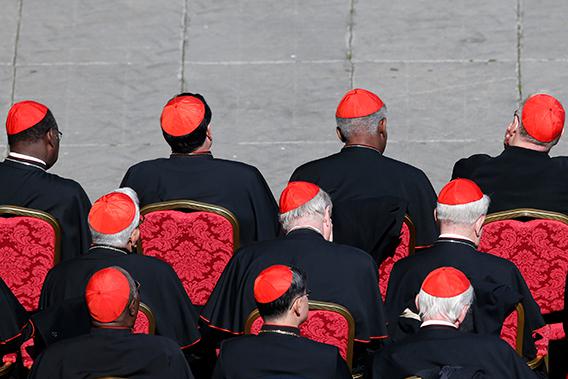Mercurius had a problem in 532 AD. He had just been elected pope, but he had been named after a pagan God. So he did something that Catholics have become quite good at: making a novel act fit into a pre-existing tradition. Mercurius asked to be called John II, after Pope John who had been martyred at Ravenna in 526 after a fallout with the Ostrogothic king, Theodoric. If Christ renamed Simon as Peter, it eventually became settled that Peter’s successors should have a new name as well.
Today the name a pope chooses for himself is more than just a name—it’s a not-so subtle indication of the direction he hopes to lead his pontificate. When Cardinal Joseph Ratzinger announced that he was taking the name Benedict in 2005, he cited the example of the last pope named Benedict, along with another Benedict, the great patron saint of Europe and of scholars. Like the former pope, he hoped to be a voice of peace during a time of war, and like the saint, he was an intellectual, being the first pope to publish a scholarly book while in office.
So when the Vatican’s conclave ends, what name will the next Bishop of Rome likely choose? Here are some of the likely (and not-so-likely) names to appear on his list and what those names would signal.
Pope Benedict XVII: Well, you can guess this one signals continuity. A new Benedict would likely signal the continuation of Ratzinger’s theological legacy, and perhaps his focus on secularism and Europe. It could be chosen by men like Canada’s Cardinal Ouellet, a contributor to a Ratzinger-founded theological journal. Or it could be taken by someone like Sri Lanka’s Cardinal Ranjith, a close admirer of Benedict’s and a partisan in the cause of a more traditional Catholic Church. Then again, Benedict’s resignation is controversial enough among the cardinals that any one of them might hesitate to take it up.
Pope John XXIV: A cardinal of any theological stripe could take the most popular of papal names. Many saints, plus an apostle, had the name. But c’mon, everyone is going to think: liberal, modernizing, back to Vatican II the moment it is announced. John XXIII had an enormous personality and made it his mission to “open the doors of the Church to the world.” He died before the council was complete, and a variety of theological schools of thought inside and outside the church have tried to attach themselves to his legacy. This is probably the most unpredictable name. But a new Pope John would at least give hope to those who want a “new church.” Anyone could claim it, but it may especially fit the Italian Cardinal Ravasi or Ghana’s Cardinal Turkson.
Pope Leo XIV: A modern social-justice pope? Although it is impossible to reduce him to one thing, Pope Leo XIII was the author of a papal letter on social inequality and justice issues that criticized both industrial capitalism and communism. His leadership unleashed waves of Catholic thinking about economic justice. Today many third world cardinals blame Western nations and banking interests for the exploitation of their flocks. They may no longer be interested in elegant debates on secularism. They may want someone calling down hellfire on Western financial interests. Look to Cardinal Turkson, or Mexico’s Cardinal Carrera.
Pope Pius XIII: The gloves come off. The mask drops. Whatever showdown battle metaphor you like best, that’s what it is going to be like if the words Qui sibi nomen imposuit Pius are used to introduce the next pontiff. Going from a pope who was a member of the Hitler Youth to one who takes the name last used by a pope smeared as “Hitler’s Pope” will be … intense in the media. Within the Catholic Church, Pius XII is rather highly regarded, but the name still really belongs to Pope St. Pius X (1903-14), who basically fumigated the church for the heresy of “modernism.” Although it could be taken by any cardinal who comes from especially humble beginnings, as Pius X did, the name will be perceived as the return of strong-handed traditionalism. Australia’s Cardinal Pell and possibly the above-mentioned Ranjith could take this name if they are especially bold.
Pope Boniface IX: Basically, everything said about Pius, but turned up till your ears bleed. It would be a gutsy man who took up the name of Boniface after Dante cast the imperious Boniface VIII into the Eighth Circle of Hell in Inferno.
John Paul III: Despite what looks increasingly like a rather inept and mismanaged reign, John Paul II was beloved in a way Benedict is not. He had a knack for the grand gesture. He was also dedicated to taking the papacy out into the world in an almost unprecedented way. It is easy to imagine an American like Dolan or O’Malley taking his name, if only for the public relations benefit.
My own wish is for a pope to revive a more ancient name and legacy. The church currently needs zeal for good order, internal justice, and a dash of drama. Rather than getting penned in by the simple binaries of traditional—modern, social—spiritual, long-retired names like Clement and Sixtus, or names waiting for their second chance like Soter and Marcus could restore the sense of otherworldliness and depth to the church. And there may be some use in those less-familiar legacies, too. In the ninth century, Pope Stephen VII had the body of his predecessor Formosus exhumed, dressed in papal vestments, and tried at the infamous “Cadaver Synod” for perjury, for mishandling church offices, and being an illegal pope. In an age of spectacular immorality in the priesthood, and high offices of the church, let us have his like again. I have several ideas for candidates and cadavers.
